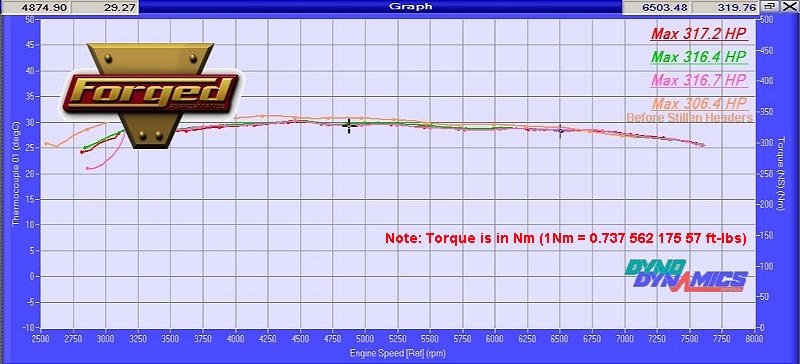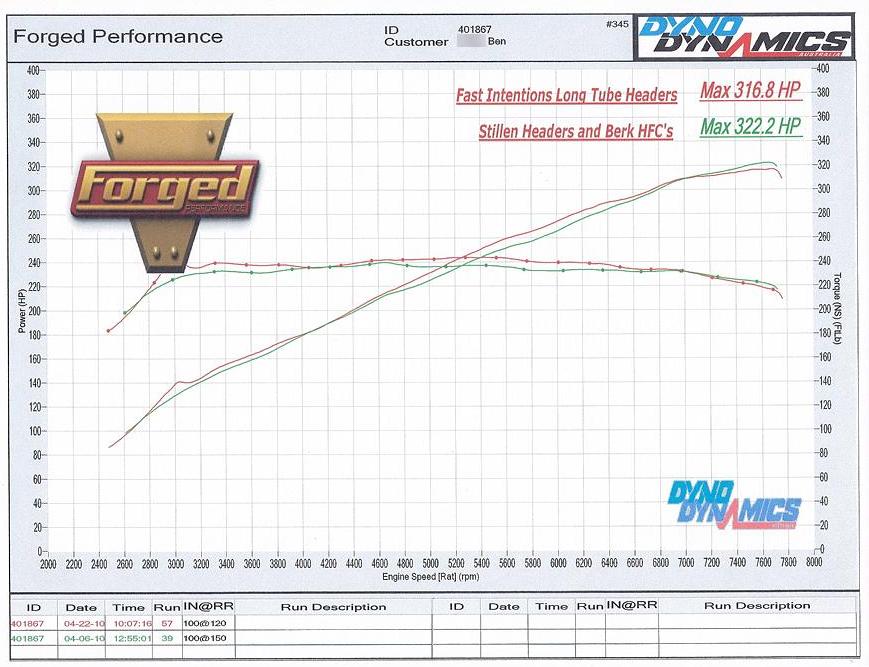Quote:
Originally Posted by RCZ

Ben, I like the results. However I just HAVE to make one comment. When I installed headers and hfc's waay back when, I know I lost a bit of torque from it and gained not too much power. Now this FI LTH loses a little power and gains a little torque back. So I HAVE to ask, what do you think would happen if you threw on the stock headers at this point. Would it make the same figures as your FI LTH? It has always made me a little curious if I would get all my lost torque back and maybe lose some top end hp if I installed the stockers back on... I don't know if headers have been a worthwhile investment on the car thus far. Maybe with forced induction since more flow = more power... but my opinion of it is rather mixed thus far. Just a thought, not trying to undermine FI's product or Stillen's...
|
That's a good question, and to be honest I'm not 100% sure. I'm inclined to say that I would have regained the lost low-end torque if I had simply thrown the stock headers back on, but I don't think I would have gained in the mid-range the way I did from the LTH.
Here is the torque chart from way back when I put on the Stillen headers.

You can see a pretty sizeable loss of tq all the way up to around 5250rpm. Now, one thing to note about this chart above is that Sharif was having an issue with a software update from Dyno Dynamics at the time, and as a result was only able to display the tq units over on the right-side Y-axis in Nm rather than ft-lbs. As I note right on the graph, ft-lbs. are smaller than Nm; 1Nm = 0.737ft-lbs. What this means is that the delta we see between the torque curves is somewhat exaggerated -- the gaps are not really as large as they visually appear to be. And all this of course makes it all the more difficult to compare to the latest graph, which displayed torque in the correct units of measure:

So what can we conclude? Well, due to the difference in units of measure, I think we need to set aside the question of whether the magnitude of the gain from the LTH matches -- or even exceeds -- the magnitude of the loss from the Stillen headers. I mean, I suppose I could break out the calculator and do a point by point conversion of the Nm curve into ft-lbs., but I don't really have the time or energy right now. I *think* my gain from the LTH exceeds the loss from the Stillen headers, which would mean I have a net gain over stock, but I'm not sure. Having said aside the
magnitude question (at least for the time being), I do think we can at least observe that, whereas the loss in tq from the Stillen headers peters out at around 5500rpm, the gain in tq from the LTH continues all the way up to about 6900rpm. So we definitely have a legit gain in tq from 5500-6900rpm. And setting all of that aside, at a bare minimum we have pretty significant weight savings over stock, which we'd obviously lose if we were to simply throw the stock manifold back on.
We also need to look at HP. Disregard the apparent gain from 306 to 317 shown in the graph above. It was later determined that the 306 baseline was messed up because they didn't pull all the way to redline. For all intents and purposes the Stillen headers yielded no change in HP. Maybe +1 or 2 on the top end at most. But look at the HP gain from the LTH. If there was no HP gain between the stock headers and the Stillen headers, yet we're seeing a real HP gain going from the Stillens to the LTH, then we can deduce that this gain would equally apply over the stock manifold.
The HP gain is pretty much across the board. The only place it falls short is at the peak, 7300rpm and above. Which brings me to my next observation. When Tony tested his LTH, he tested it against a car running the stock manifold and his HFCs. Check out his gains:

What's the difference? Well, part of it, obviously, is that his baseline ran the stock manifold whereas mine was with the Stillen header. But we can already see from above that the delta between the stock and Stillen headers is marginal for tq, and non-existent for hp. So that's not it. Okay, my baseline was with Berk HFC while Tony's was with his F.I. HFC. Well, I'm sure there are some differences, but I can't believe that Tony's HFC is so much more restrictive than Berk that it would account for such a big difference in gains from the LTH (which deletes the HFC).
That leaves just one other factor, doesn't it? Tony is running his F.I. CBE, while I'm still running Stillen's. Tony and I have actually discussed all this, and our working theory right now is that the Stillen CBE is holding my car back. Tony thinks that there's now too much flow with the LTH for the Stillen CBE to handle, so the CBE is bottlenecking the flow. And I have to say, based on the process of elimination I just took us through above, I don't see a more logical conclusion. Indeed, notice the similarities between Tony's graph and mine. Both show the same pattern of a large jump in TQ on the low end, followed by a convergence of the lines right at around 4k rpm, and then divergence after that. The big difference is in what happens after that. On Tony's graph, the two lines continue to diverge in an ever widening path, i.e., his
rate or magnitude of gain increases as rpm goes up. But with my graph, the gap stays pretty much constant from 5k to 6200k, where it then changes direction and eventually crosses over at around 7k and actually dips down below the baseline shortly thereafter. Hmm . . . it's as if the system runs out of breath at the final stretch, isn't it?
And that's why I now have the F.I. CBE on order (12" resonators w/ CF mufflers). And of course, I plan to do a before and after dyno just like I did with the LTH so we can have objective data to tell us for sure. It will essentially be a showdown between the Stillen and F.I. CBEs. This is what I expect the results to be: we already know that F.I.'s CBE makes more power over Stillen's, but up until now, the advantage has been somewhat marginal, IMO. Certainly not enough for me to justify the expense of laying out the money for an F.I. exhaust. But the comparison numbers we have (from Tony) to this point between these two CBEs is from a car equipped with stock manifolds and stock cats (I think F.I.'s advantage with everything else stock is only like +1 or 2whp if I remember correctly).
I believe the LTH is the game changer. Once you uncork everything with the LTH, suddenly the difference in gain between the two CBEs becomes magnified. That's the working theory. The dyno results will tell us if we (Tony and I) are correct or not.